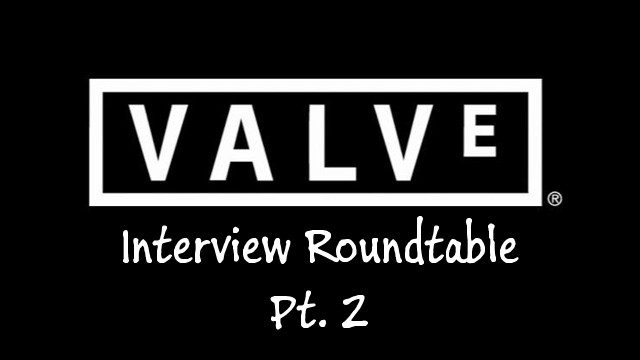Welcome to Part 2 of our Valve Interview Roundtable series. This week we had a chance to visit Valve’s headquarters in Bellevue, Washington to participate in a press interview roundtable where we spoke to several notable figures at the company, including founder Gabe Newell. In this multi-part series we will go over major talking points regarding software and the Steam platform.

- Part 1: Team Fortress 2
- Part 2: Counter-Strike: Global Offensive
- Part 3: Virtual Reality
- Part 4: Steam
After talking about Team Fortress 2 for a few minutes, the discussion moved to Counter-Strike: Global Offensive, led by Valve team members Eric Johnson, Brian Levinthal, and Ido Magal.
Eric Johnson kicked things off with confirmation that Dust 2 is being reworked. “The goal is to update both the gameplay and visuals of the map”, Johnson said in response to being asked whether or not it’d be to the scale of something like Train, “This is the most popular map in Counter-Strike, but it’s also the oldest looking.” The team joked about how the reworked map will be set on a “moon base” before saying that it will address the map’s problems, most prominent of which is its staleness from age. Dramatic changes are possible, although it was clear during our discussion that development of the map had just begun.
Related: 3 Ways Dust 2 Was Almost Completely Different
Although there is no timeline for reworked Dust 2’s release, Johnson did share that Valve doesn’t like to “sit on” completed content. In other words, when development of the map is complete, it’ll be published whether or not the next operation is ready. And yes, there’s an operation on the horizon.

I had an opportunity to ask about how the team views Overwatch, particularly its eSport presence. Valve understands that competition is a good thing for the industry, but at this time there “isn’t enough data” to show whether or not Blizzard’s tournament formatting and pro league are the best solution. Ido Magal would chime in saying that “it’s just a good game” before Johnson added that the team plays Overwatch and is excited to “see what [Blizzard] do”.
The discussion then shifted to community contribution. Valve sees community participation as an active and vital element of the game’s success, such as in the case of players voting for which weapon skins and stickers will transition from the community hub into the game. “The future is trying to find more ways that the community can express themselves in the game”, said Johnson. The team went as far as to agree that at some point in the future mod creators, such as the one most recently responsible for Classic Offensive, should have the opportunity to make real-world money from their work.
The Source 2 engine was then mentioned, prompting confirmation from Valve that it’s in CS:GO‘s future in addition to virtually every other game it makes. Magal made the point that Source 2 will make modability and community input much more streamlined.
Valve was then probed about the gambling scene, a topic that has been stirring controversy during recent years. Johnson mentioned that Valve doesn’t want to be associated with the gambling scene, saying that “it violates [Valve’s] terms of service”, and as they “become aware of it they shut [gambling sites] down”.
This was demonstrated in July of last year when Valve sent out a total of 23 letters to major CS:GO gambling sites requesting that they cease and desist. Notable sites such as CSGO Lotto soon went under from fear of a lawsuit. Despite this effort, dozens if not hundreds of sites remain, driving millions of dollars in revenue per year, many times with participation from underage users.

Some would argue that the gambling scene has contributed to significant growth of CS:GO over recent years. Valve isn’t so sure, with Magal saying that it “doesn’t have data to support that”. Johnson would go on to explain that the addition of matchmaking was a major reason for the game’s significant increase in popularity after a tumultuous first few months on the market. Following this, infrequent but substantial updates have managed to grow the game over time, to the point where it’s now capable of achieving 11 million active users per month, a figure that very few games in history have been able to accomplish.
Related: How Microtransactions Propelled CS:GO To Stardom
To close the discussion about CS:GO, I asked about optimization, citing a recently popular post on the Global Offensive subreddit sharing Cloud 9 professional player Mike “shroud” Grzesiek’s concerns regarding performance. Johnson replied saying “you can have global optimization issues that we’re pretty data driven about”, not necessarily confirming or denying that the game has any outstanding performance problems in its current state. Levinthal mentioned that there is a large sum of players with older hardware who submit feedback, but they’re “always paying attention to perf”, adding that it’s “ongoing work and an ongoing conversation”.
While I got the impression that CS:GO optimization wasn’t a huge concern of Valve, it was very clear that it takes feedback seriously. During our more than three hours of discussion during the day, the importance of feedback was brought up multiple times. With that, it’s clear that consumers should continue to share their thoughts on Valve’s products in an effort to help shape them into something better.
This concludes part 2 of our Valve Interview Roundtable series. In part 3 we will talk about what we learned about the HTC Vive and what Gabe Newell thinks of virtual reality’s future.







